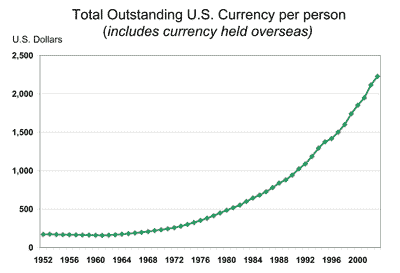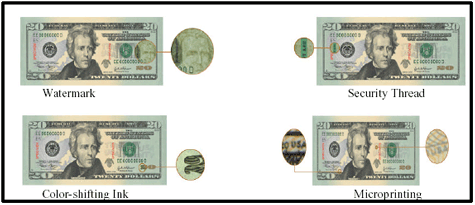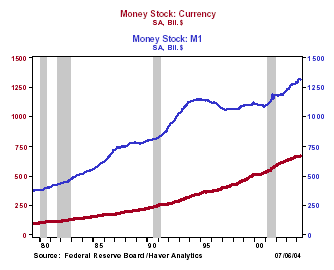By currency, I assume you mean Federal Reserve notes? As of March 2004, about $667 billion in currency was in the hands of the public, both foreign and domestic, that was included in the U.S. money supply. Currency is included in all measures of the money supply, including the well-known varieties, M1, M2, and M3.
The other part of your question raises an interesting question—just how common is counterfeit currency in 2004? Well, you will be pleased to know the amount is so minimal it has no effect on today’s economy!
Currency in the hands of the public
According to the June 24, 2004, Federal Reserve Statistical Release H.6 (508), Money Stock Measures, seasonally adjusted currency in the hands of the public averaged around $667 billion in March 2004. Currency in the hands of the public excludes currency held by the U.S. Treasury, Federal Reserve Banks, and currency stored in the vaults of depository institutions, mainly banks, savings institutions, and credit unions.
Where in the world is all of that U.S. currency?
While currency in the hands of the public is a key component of the money supply measures, you might be surprised to learn that most of the U.S. currency is circulating overseas. According to the Preface of a March 2003 Report to the Congress by the Secretary of the Treasury, about 60 percent of the outstanding U.S. currency was held overseas; in 2003 that was about $370 billion!
Chart 1

Counterfeit currency?
With all of that currency in circulation, the U.S. Secret Service works very hard to protect the reputation of our currency. In fact, when the Secret Service was founded on July 5, 1865, its primary task was to minimize the counterfeiting problem; at that time, about one-third to one-half of the nation’s currency was counterfeit. As a testament to the Secret Service’s efforts, in fiscal year 2001, the U.S. Treasury estimated that less then .01 percent of approximately $600 billion in U.S. currency in circulation was counterfeit! (See page 50.)
The Fed also plays a role in protecting the nation’s currency from counterfeits when it removes unfit currency from circulation. When a bank makes a deposit of excess or old currency into the Fed’s vault, each bill undergoes an extensive verification process using sophisticated equipment. The Fed uses high speed machines to count each bill. These machines can count 40 bills a second, and while they count the bills, they also examine them for their fitness level using specially designed sensors. These sensors detect dirt content, graffiti, and possible counterfeits. Suspected counterfeits are sent to the Secret Service for examination. All other unfit currency is shredded. The Twelfth District shreds 75 million dollars a day! (See “Currency and Coin” in the frbsf.org FAQ section) The shredded currency is then replaced with newly printed bills ordered from the U.S. Bureau of Engraving and Printing (BEP).
The BEP constantly updates currency to make it more difficult to counterfeit. A newly redesigned $20 was issued in fall 2003. Along with a color change, this bill contained four distinct security features: color-shifting ink, a watermark, a security strip, and microprinting. Figure 1 demonstrates these features.
Figure 1

A new $50 bill will be issued in September 2004 and a new $100 bill in Spring 2005. The one, two, five, and ten dollar bills will follow shortly thereafter.
Currency in the U.S. money supply
Currency is the largest component of the M1 money supply measure. As of March 2004, currency accounted for more than half of the narrow M1 monetary aggregate. The other major components of the M1 aggregate are non-interest bearing demand deposits (or checking account balances) and other checkable deposits—mainly interest-bearing NOW accounts and share drafts at credit unions. Chart 2 shows the historical growth of both currency and M1; note that the growth path of currency in recent decades has been much smoother than the M1 measure of the money supply.
The increased volatility of the money supply measures relative to the economy is a key reason the Fed only monitors the monetary aggregates—policy targets are now set by adjusting the federal funds target interest rate using open market operations. Finally, the Table breaks down the major components of the three money supply measures, M1, M2, and M3, and shows how currency is counted in each aggregate. (See Dr. Econ, January 2003 for additional information).
Chart 2

|
Table 1
|
|
|
Money Supply Components
|
Billions of $, March 2004
|
| + Currency |
666.7
|
| + Demand deposits |
326.0
|
| + Other checkable deposits |
324.6
|
| + Travelers checks |
7.8
|
| M1 |
1,325.1
|
| + Savings deposits, including MMDAs |
3,278.5
|
| + Small time deposits |
802.6
|
| + Retail money funds |
750.0
|
| M2 |
6,156.2
|
| + Institutional money funds |
1,111.8
|
| + Large time deposits |
930.1
|
| + Overnight & term RPs |
523.2
|
| + Overnight & term Eurodollars |
290.4
|
| M3 |
9,011.7
|
| For precise definitions please see Federal Reserve Board H.6 Release | |
| MMDA = Money Market Deposit Accounts RPs = Repurchase agreements. From H.6 Release for June 24, 2004. Later releases included revisions. |
|
References
[urls access September 2004]
Money Stock Measures. H.6. Release. Board of Governors of the Federal Reserve System.
http://www.federalreserve.gov/releases/
“The Use and Counterfeiting of U.S. Currency Abroad”, Part 2. March 2003. The Department of the Treasury, United States Secret Service, and Board of Governors of the Federal Reserve System.
http://www.treas.gov/press/releases/docs/counterfeit.pdf
U.S. Bureau of Engraving and Printing website.
http://www.moneyfactory.com/
U.S. Treasury website.
http://www.ustreas.gov/